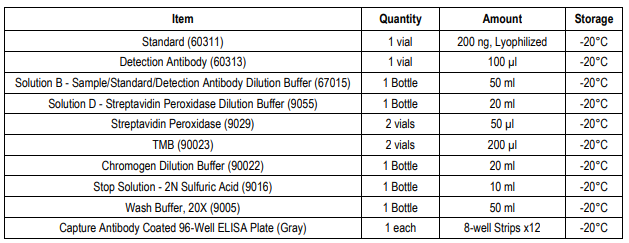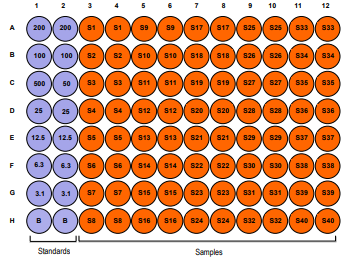Description
HDM (Der p 10) Detection Assay Kit - Cat Number: 6031 From Chondrex.
Research Field: Allergy
Clonality: N/A
Cross-Reactivity:
Host Origin: N/A
Applications: N/A
Isotype: N/A
Detection Range: 200 ng/ml-3.13 ng/ml
Sample Type: Liquid Samples
Concentration: N/A
Immunogen:
PRODUCT SPECIFICATIONS
DESCRIPTION: ELISA Kit to quantify house dust mite (Der p 10)
FORMAT: Pre-coated 96-well ELISA Plate with removeable strips
ASSAY TYPE: Sandwich ELISA
ASSAY TIME: 4 hours
STANDARD RANGE: 200 - 3.1 ng/ml
NUMBER OF SAMPLES: Up to 40 (duplicate) samples/plate
SAMPLE TYPES: Culture media, serum, plasma, and solubilized samples (extracts)
RECOMMENDED SAMPLE DILUTIONS: 1:1 (at least)
CHROMOGEN: TMB (read at 450 nm)
STORAGE: -20°C for 12 months
VALIDATION DATA: Intra-Assay (3.8-6.2%)/Inter-Assay (2.4-8.9%)/Spiking Test (93-105%)
NOTES:
INTRODUCTION
Allergic diseases and symptoms arise from an active immune response to antigens which are usually harmless, such as pollen, pet dander,
or food. Specifically, food allergies and asthma are two common childhood autoimmune diseases that have affected more individuals recently.
A food allergy is an immune response to foods or food ingredients that most other people can tolerate with no problem. Chicken egg allergy
is the second most common food allergy (the first being bovine milk allergy) and is observed in 0.5 to 2.5% of young children. Egg allergy is
an immunological reaction induced by egg proteins and is defined as an allergen-specific IgE antibody-mediated allergy, also known as a
type I food allergy. Among egg proteins, ovalbumin (OVA) is one of the identified allergenic proteins (1) (2).
Asthma is a chronic inflammatory disease that affects 300 million people of all ages worldwide (3). It is caused by exposure to allergens such
as dust mites, pet dander, pollen, or mold, and characterized by airflow obstruction and bronchospasm. House dust mite (HDM) allergens
are the most important indoor allergens in humans (3). Approximately 10% of asthma patients sensitized to HDM demonstrate IgE antibodies
to the tropomyosin protein (Der p10) from dust mite, Dermatophagoides pteronyssinus (2). Der p10 is a 32 kDa, group 10 allergen
(tropomyosins). Tropomyosins of a similar structure are found in invertebrates such as crustaceans (shrimp, lobster, crawfish, and crab),
arachnids (house dust mites), insects (cockroaches), and mollusks. Tropomyosin is a heat-stable protein and sensitization may lead to
severe reactions to the allergenic source. Therefore, the Der p10 antigen may play a role in the cross-induction of allergic reactions to many
allergens. (4)
To analyze the pathogenesis of these allergens, OVA and HDM (Der p 10), in allergic reactions in patients or animal disease models, Chondrex, Inc. provides allergen detection ELISA kits. For more information, please visit www.chondrex.com or contact support@chondrex.com.
NOTE: This kit does not detect the tropomyosin protein (Group 10 allergen) from Dermatophagoides farinae (Der f 10).
KIT COMPONENTS

ASSAY OUTLINE

PLATE MAPPING

NOTES BEFORE USING ASSAY
NOTE 1: It is recommended that the standard and samples be run in duplicate.
NOTE 2: Warm up all buffers to room temperature before use.
NOTE 3: Crystals may form in Wash Buffer, 20X when stored at cold temperatures. If crystals have formed, warm the wash buffer by placing
the bottle in warm water until crystals are completely dissolved.
NOTE 4: Measure exact volume of buffers using a serological pipet, as extra buffer is provided.
NOTE 5: Cover the plate with plastic wrap or a plate sealer after each step to prevent evaporation from the outside wells of the plate.
NOTE 6: For partial reagent use, please see the assay protocol’s corresponding step for the appropriate dilution ratio. For example, if the
protocol dilutes 50 µl of a stock solution in 10 ml of buffer for 12 strips, then for 6 strips, dilute 25 µl of the stock solution in 5 ml of buffer.
Partially used stock reagents may be kept in their original vials and stored at -20⁰C for use in a future assay.
NOTE 7: This kit contains animal components from non-infectious animals and should be treated as potential biohazards in use and for
disposal.






